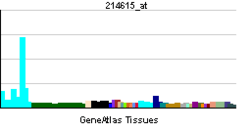P2RY10
| P2RY10 | |||||||||||||||||
|---|---|---|---|---|---|---|---|---|---|---|---|---|---|---|---|---|---|
| Identifiers | |||||||||||||||||
| Aliases | P2RY10, LYPSR2, P2Y10, purinergic receptor P2Y10 | ||||||||||||||||
| External IDs | MGI: 1926076 HomoloGene: 8717 GeneCards: P2RY10 | ||||||||||||||||
| Targeted by Drug | |||||||||||||||||
| lysophosphatidic acid, sphingosine 1-phosphate[1] | |||||||||||||||||
| |||||||||||||||||
| RNA expression pattern | |||||||||||||||||
 | |||||||||||||||||
| More reference expression data | |||||||||||||||||
| Orthologs | |||||||||||||||||
| Species | Human | Mouse | |||||||||||||||
| Entrez | |||||||||||||||||
| Ensembl | |||||||||||||||||
| UniProt | |||||||||||||||||
| RefSeq (mRNA) | |||||||||||||||||
| RefSeq (protein) | |||||||||||||||||
| Location (UCSC) | Chr X: 78.95 – 78.96 Mb | Chr X: 107.09 – 107.1 Mb | |||||||||||||||
| PubMed search | [2] | [3] | |||||||||||||||
| Wikidata | |||||||||||||||||
| View/Edit Human | View/Edit Mouse |
Putative P2Y purinoceptor 10 is a protein that, in humans, is encoded by the P2RY10 gene.[4][5][6]
The protein encoded by this gene belongs to the family of G-protein coupled receptors that is preferentially activated by adenosine and uridine nucleotides. Two alternatively spliced transcript variants encoding the same protein isoform have been found for this gene.[6]
See also
References
- ↑ "Drugs that physically interact with Putative P2Y purinoceptor 10 view/edit references on wikidata".
- ↑ "Human PubMed Reference:".
- ↑ "Mouse PubMed Reference:".
- ↑ Adrian K, Bernhard MK, Breitinger HG, Ogilvie A (Sep 2000). "Expression of purinergic receptors (ionotropic P2X1-7 and metabotropic P2Y1-11) during myeloid differentiation of HL60 cells". Biochim Biophys Acta. 1492 (1): 127–38. doi:10.1016/S0167-4781(00)00094-4. PMID 11004484.
- ↑ Ralevic V, Burnstock G (Nov 1998). "Receptors for purines and pyrimidines". Pharmacol Rev. 50 (3): 413–92. PMID 9755289.
- 1 2 "Entrez Gene: P2RY10 purinergic receptor P2Y, G-protein coupled, 10".
Further reading
- Berchtold S, Ogilvie AL, Bogdan C, et al. (2000). "Human monocyte derived dendritic cells express functional P2X and P2Y receptors as well as ecto-nucleotidases.". FEBS Lett. 458 (3): 424–8. doi:10.1016/S0014-5793(99)01197-7. PMID 10570953.
- Strausberg RL, Feingold EA, Grouse LH, et al. (2003). "Generation and initial analysis of more than 15,000 full-length human and mouse cDNA sequences.". Proc. Natl. Acad. Sci. U.S.A. 99 (26): 16899–903. doi:10.1073/pnas.242603899. PMC 139241
 . PMID 12477932.
. PMID 12477932. - Gerhard DS, Wagner L, Feingold EA, et al. (2004). "The status, quality, and expansion of the NIH full-length cDNA project: the Mammalian Gene Collection (MGC).". Genome Res. 14 (10B): 2121–7. doi:10.1101/gr.2596504. PMC 528928
 . PMID 15489334.
. PMID 15489334. - Ross MT, Grafham DV, Coffey AJ, et al. (2005). "The DNA sequence of the human X chromosome.". Nature. 434 (7031): 325–37. doi:10.1038/nature03440. PMC 2665286
 . PMID 15772651.
. PMID 15772651.
This article incorporates text from the United States National Library of Medicine, which is in the public domain.
This article is issued from Wikipedia - version of the 10/23/2016. The text is available under the Creative Commons Attribution/Share Alike but additional terms may apply for the media files.